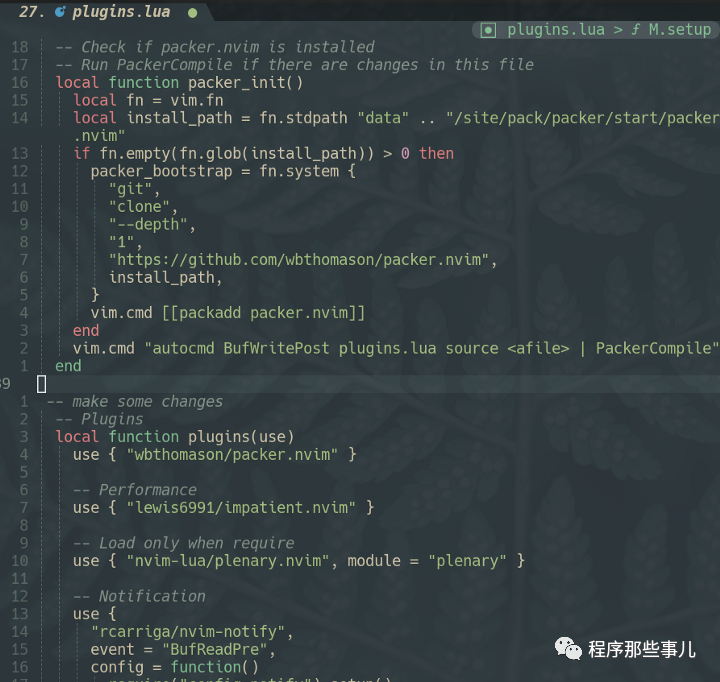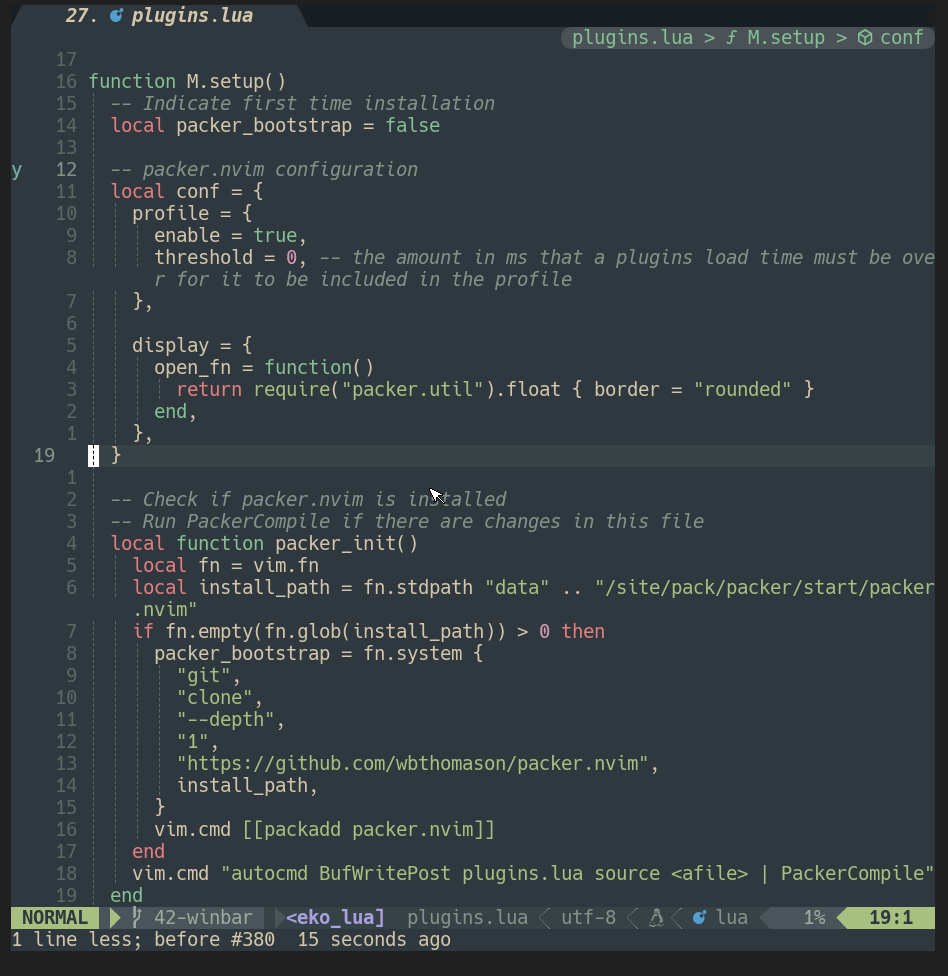通过一个插件来了解neovim的winbar属性
通过一个插件来了解neovim的winbar属性

程序那些事儿
发布于 2023-03-07 11:10:44
发布于 2023-03-07 11:10:44
代码可运行
运行总次数:0
代码可运行
window bar
window bar 是显示在每个窗口的上面的,默认它是不显示的,你需要配置才可以。你可以把它看成和底部的状态栏类似的东西,只不过它显示在窗口顶部。

通过:h winbar命令可以查看它的帮助文档。我们可以通过配置选项来配置winbar的显示内容。
配置的命令是vim.opt.winbar=配置内容。
代码上下文
winbar 可以显示任何内容,但是我们更多的时候是希望它显示一些有意义的内容,比如文件名和一些代码的函数名,属性信息等,此外,我们还可以显示文件的状态,比如文件是否被修改了。

函数api介绍
- get_winbar 函数用来显示当前代码的上下文信息
- get_location 函数用来获取当前代码的上下文。
- get_modified 用来显示文件名,检查文件是否修改,如果修改显示图标。
- WinBarSeparator, WinBarContext, and WinBarFilename 是用来显示自定义的高亮。
在代码中我们使用nvim-navic插件来帮助我们获取代码的上下文更详细的信息。
高亮配置
为了更好地显示窗口样式,我们可以通过修改winbar提供的高亮组样式来修改winbar的样式。

- WinBar 用来配置当前窗口的样式
- WinBarNC 用来配置非当前窗口样式。
主要代码
local M = {}
local colors = require "config.colors"
local navic = require "nvim-navic"
local utils = require "utils"
local icons = require "config.icons"
vim.api.nvim_set_hl(0, "WinBarSeparator", { fg = colors.grey })
vim.api.nvim_set_hl(0, "WinBarFilename", { fg = colors.green, bg = colors.grey })
vim.api.nvim_set_hl(0, "WinBarContext", { fg = colors.green, bg = colors.grey })
M.winbar_filetype_exclude = {
"help",
"startify",
"dashboard",
"packer",
"neogitstatus",
"NvimTree",
"Trouble",
"alpha",
"lir",
"Outline",
"spectre_panel",
"toggleterm",
}
local excludes = function()
if vim.tbl_contains(M.winbar_filetype_exclude, vim.bo.filetype) then
vim.opt_local.winbar = nil
return true
end
return false
end
local function get_modified()
if utils.get_buf_option "mod" then
local mod = icons.git.Mod
return "%#WinBarFilename#" .. mod .. " " .. "%t" .. "%*"
end
return "%#WinBarFilename#" .. "%t" .. "%*"
end
local function get_location()
local location = navic.get_location()
if not utils.is_empty(location) then
return "%#WinBarContext#" .. " " .. icons.ui.ChevronRight .. " " .. location .. "%*"
end
return ""
end
function M.get_winbar()
if excludes() then
return ""
end
if navic.is_available() then
return "%#WinBarSeparator#"
.. "%="
.. ""
.. "%*"
.. get_modified()
.. get_location()
.. "%#WinBarSeparator#"
.. ""
.. "%*"
else
return "%#WinBarSeparator#" .. "%=" .. "" .. "%*" .. get_modified() .. "%#WinBarSeparator#" .. "" .. "%*"
end
end
return M
总结
neovim的插件目前几乎都是用lua进行编写的,lua使用起来不仅效率高,而且配置起来也非常的方便,此外,neovim也在不断地完善自己的api,用户开发起来变得非常轻松。
本文参与 腾讯云自媒体同步曝光计划,分享自微信公众号。
原始发表:2022-11-08,如有侵权请联系 cloudcommunity@tencent.com 删除
评论
登录后参与评论
推荐阅读
目录

